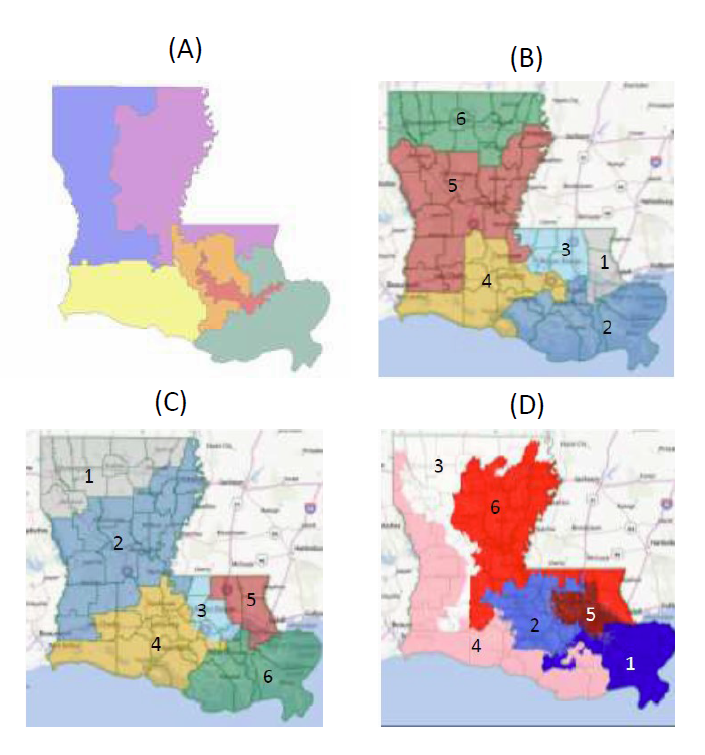I have a deeply held conviction that gerrymandering is the fundamental political problem facing the United States. This conviction is more or less uninformed by actual theory, evidence, or firsthand knowledge of American politics. For, like many economists and political scientists, I only use evidence to inform my opinions of my professional work.
Nonetheless, I am delighted by this quiz from John Sides over at Monkey Cage. Which Louisiana maps illustrate the most and the least gerrymandered system?  The answer is not what you expect.
The answer is not what you expect.
As it happens, Justice Stevens agrees with me about gerrymandering, going so far as to suggest a constitutional amendment to inhibit it. (Technically, of course, it might be more accurate to say I agree with Justice Stevens.) Pointers to other literature welcome.

14 Responses
If Gerrymandering were the root of the problem, then the Senate would be less dysfunctional than the house. I think it’s difficult to argue that that’s the case.
the fundamental political problem in the US is the ancient voting district based system, instead of more modern system with a proportional representation.
Instead of a broad political spectrum, all opinions have to conform to only two party lines.
Not a recipe for a debate with nuances/ Oh yes, the presidential system is also something you would never go for in an age the telegraph exists.
@cblatts Some additional reading on gerrymandering: http://t.co/NOhEyCXmct
What does political gerrymandering look like? http://t.co/BwgxIWnNSA
RT @jonmladd: Districts can have big consequences apart from their compactness or their (non)effects on polarizat… http://t.co/ZYtDq93g0X
Districts can have big consequences apart from their compactness or their (non)effects on polarization. I expand on this here: http://www.mischiefsoffaction.com/2014/05/gerrymandering-is-useless-concept.html
(Partisan balance between Democrats and Republicans is far from the only or most important thing that matters in politics. It’s just the most fun and easy to talk about for many.)
People will respond “gerrymandering doesn’t matter because it doesn’t cause polarization.” That statement shows how narrow-minded we are.
What does political gerrymandering look like?: I have a deeply held conviction that gerrymandering is the fund… http://t.co/9873kkeUZm
If I could change just one thing, it would be too get rid of plurality voting. Just about anything, IRV, Approval Voting, etc. would be better. Gerrymandering is a natural fall-out of a voting system that biases us towards only having two parties.
@cblatts See also http://t.co/lHfggt1ieE
.@cblatts killer chart below — shows simulated districts created from Florida in 2000 (which was 50-50 Gore/Bush) http://t.co/ZqMJvtFmNs
.@cblatts I think gerrymandering matters, but this paper by Rodden and Chen has tempered my priors a great deal http://t.co/KwfdDdC66P
What does political gerrymandering look like? http://t.co/k8R6viQ4f1 via @jetpack